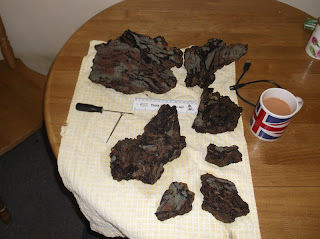
Today i excavated the beck bank at stainsby beck in the south west area of Cleveland. The images show blue Mercia mudstone ( Triassic) that i uncovered.
I discovered that the Mercia mudstone is covered in exactly the same alluvial red-brown loamy friable clay that covers the Stainton gravel beds. but the gravel beds here are abscent, the very hard blood red clay that sits directly above the flat laying Mercia mudstone, has no rocks or pebbles in it, and both is intruded by and intrudes the Mercia mudstone.
Note how flat the Mercia mudstone is as are all the superficial deposits Ive excavated in the south west area of Cleveland.
The image above shows the very hard blood red clay that sits directly above the Mercia mudstone.
The last image shows the top red -brown loamy friable clay that that covers every excavation i have carried out in the south west area of Cleveland. With the blood red very hard clay below.
The geological layers found at this location are as follows -
Red - brown loamy friable clay, with very little stone or pebble content.
Blood red hard packed stoneless very dry clay, average thickness 300-400 mm
Mercia mudstone containing Tufa with fossils.
Ive recently been informed by Andy Cooper a good friend and in my mind an expert in the geology of the Cleveland area, that the red stone-clay could be the result of a fault in the Mercia deposits.
I have informed Andy that ive found that the Mercia mudstone outcrop in the Stainsby beck area of Thornaby on tees, is a lot larger than first reported, ive identified at least a 200 metre stretch of the western bankside, has visible mudstone outcrops.



















































